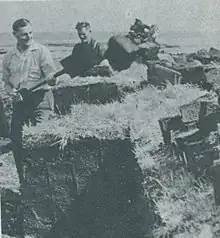I can't find anything on the strong claim that Falkland Islanders only had peat as fuel.
So this isn't a complete answer.
However official government publications do support the idea that peat was a major fuel source on the islands until around 1982 and before that from 1974 by treaty the Argentinian state oil company had a legal monopoly on importing oil to the Falklands and prior to that commerce was partly restricted.
http://www.falklands.gov.fk/assets/OurIslandsOurHistory.pdf
peat is very common on the Islands and provided warmth
for almost every household for the first
hundred or so years of British rule. Although
effectively free, cutting peat was a laborious
task and once it was dried it was not a
particularly efficient fuel. In Stanley a
public holiday was designated for the work.
Since the 1982 Conflict peat has largely been
replaced by fuel oil.
a timeline notes:
1974: A sovereignty umbrella is established to allow commercial
transactions to be carried out between the Falkland Islands
and Argentina. Agreement signed for supply of fuel by
Argentine state oil company, YPF
...
In 1974 a ‘sovereignty umbrella’
was introduced to cover all possible commercial
transactions and it was under this that the
supply of fuel to the Islands was given as a
monopoly to the Argentine state oil company
YPF.
...
Stanley before the Argentine
invasion was a town in decline. Access to
the Falklands was effectively controlled by
LADE, the commercial arm of the Argentine
air force, which provided the only regular link
to the outside world. The Argentine state oil
company, YPF, provided all the Islands’ fuel. It
seemed that the Falklands were sliding into
the arms of Argentina. Emigration, to the UK or
New Zealand, increased and the birth rate fell.
The population of the Islands declined to 1,800.
It took the events of 1982 to reverse
the trend.
...
